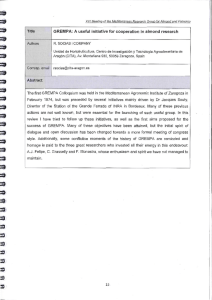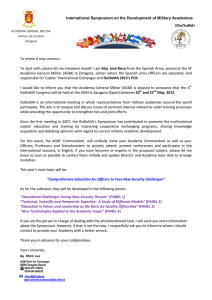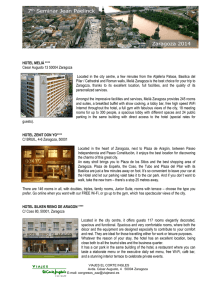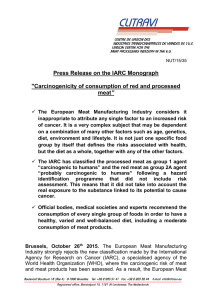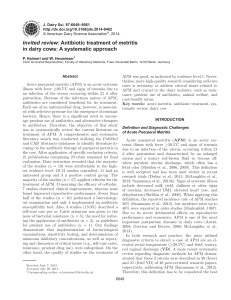FOOD INDUSTRIES OF ANIMAL ORIGIN
Anuncio
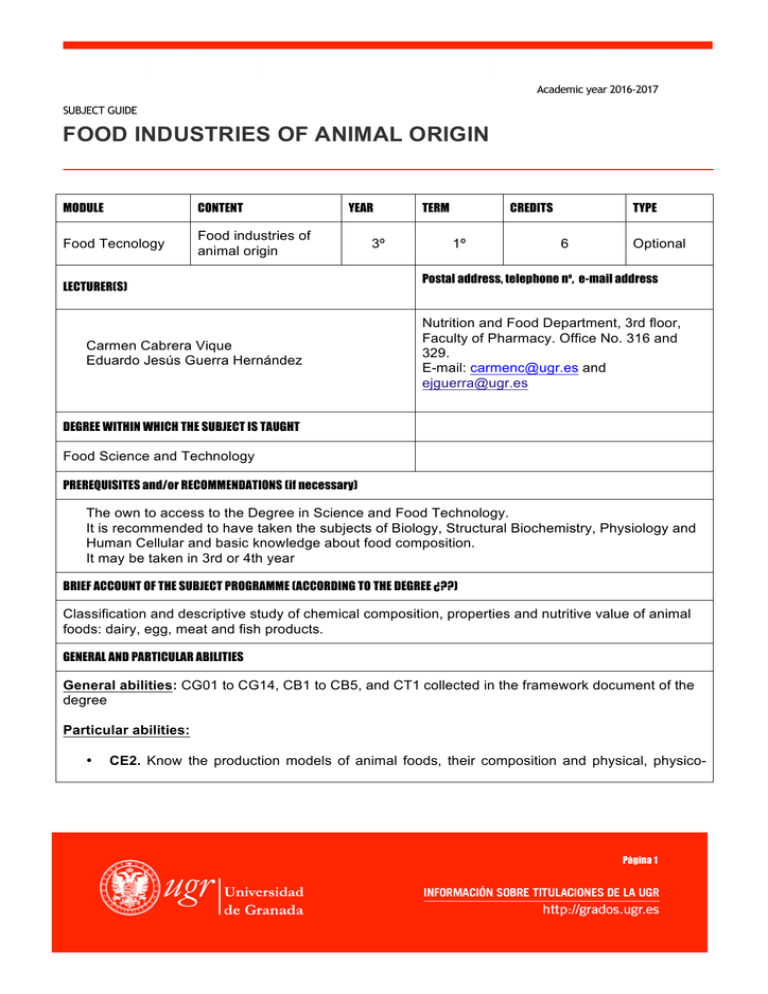
Academic year 2016-2017 SUBJECT GUIDE FOOD INDUSTRIES OF ANIMAL ORIGIN MODULE CONTENT Food Tecnology Food industries of animal origin YEAR LECTURER(S) Carmen Cabrera Vique Eduardo Jesús Guerra Hernández 3º TERM CREDITS 1º TYPE 6 Optional Postal address, telephone no, e-mail address Nutrition and Food Department, 3rd floor, Faculty of Pharmacy. Office No. 316 and 329. E-mail: carmenc@ugr.es and ejguerra@ugr.es DEGREE WITHIN WHICH THE SUBJECT IS TAUGHT Food Science and Technology PREREQUISITES and/or RECOMMENDATIONS (if necessary) The own to access to the Degree in Science and Food Technology. It is recommended to have taken the subjects of Biology, Structural Biochemistry, Physiology and Human Cellular and basic knowledge about food composition. It may be taken in 3rd or 4th year BRIEF ACCOUNT OF THE SUBJECT PROGRAMME (ACCORDING TO THE DEGREE ¿??) Classification and descriptive study of chemical composition, properties and nutritive value of animal foods: dairy, egg, meat and fish products. GENERAL AND PARTICULAR ABILITIES General abilities: CG01 to CG14, CB1 to CB5, and CT1 collected in the framework document of the degree Particular abilities: • CE2. Know the production models of animal foods, their composition and physical, physico- Página 1 chemical and chemical properties to determine its nutritional value and functionality. • CE3. Learn the techniques and food analysis to ensure optimal conditions for human consumption. • CE6. Know, understand and apply the classical methodology and the new technological processes to improve the production and processing of food. • CE15. Inform, educate and advise legal, scientifically and technically to the public administration, the food industry and consumers to design intervention strategies and training in the field of science and food technology. OBJECTIVES (EXPRESSED IN TERMS OF EXPECTED RESULTS OF THE TEACHING PROGRAMME) - Assess the present development of the Spain and EU dairy sector in terms of production, consumption, legislation, and socio-economic importance Know the chemical composition and elaboration of derivatives of milk, egg, meat and fish with special attention to new products Know the common analytical techniques in elaboration quality control Study of new technologies of dairy products with special reference to use of subproducts DETAILED SUBJECT SYLLABUS THEORICAL CONTENT MODULE 1. Dairy products Item 1. Definitions. Characteristics of raw materials. Historical overview of the main dairy products. Importance and current of the dairy sector. Production, consumption and future prospects (2 hours) Item 2.-Treatment and transformation of milk. Technology of dairy products. Thermic treatments. Centrifugation. Normalization of fat content. Bactofugation. Filtration. Evaporation. Other treatments (3 hours) Item 3. Fermented milks. Definition and classification. Yogurt. Kefir. Koumis. New generation of fermented milks. Technological process of elaboration. Enzymes. Ingredients with functional properties. Quality control . (4 hours) Item 4.- Cream and Butter. Definition. Chemical composition. Tecnological proccess of elaboration of cream and butter. New products. Interest in food science. Control of alterations. (1 hours) Item 5. Ice cream. Definition and classification. Ingredientes. Elaboration techniques. Chemical composition. Microbiological and sensory control. (1 hours) Página 2 Item 6.- Cheese. History. Their Importance in Mediterranean diet. General process of elaboration. Enzymes. Maturation: microbiologial and biochemical aspects. Quality control. Legislation. Cheese types more representative. Chemical composition and nutritive value. . (3 hours) . Item 7. Other dairy products. Curd. Cottage cheese. Smoothies and Dairy desserts. Chemical composition. Technological process of manufacture. Quality control. (3 hours) Item 8. By-products of the dairy industry. Caseinates. Whey. Whey proteins. Their obtention. Importance in the food industry. Investigation, Research, development and technological innovation . (3 hours). MODULE 2. Meat products Item 9. Transportation of animals before slaughter. Sacrifice of animals. Marketing and technological aspects (1 hour). Item 10. Properties of myo-meat systems. Post-mortem metabolism. Structure of skeletal muscle tissue. Post-mortem changes of muscle and abnormal processes. PSE and DFD meat. Chemical composition of meat (1 hour). Item 11. Sensory properties of meat. Juiciness. Color. Texture and hardness. Smell and Taste (2 hours). Item 12. Meat conservation by cold application. Refrigeration and freezing. Methods Used: advantages and disadvantages (2 hours). Item 13. Meat products. Definition. Classification. Functional properties of proteins. Raw meat products, raw pickled meat products and cured meat products. General process of manufacture. Raw material selection. Ingredients. Formulation. Dough preparation. Equipments used in the meat Industry. Alterations and defects in raw-cured products. (4 hours). Item 14. Meat products (continuation). Heat-treated meat products. Meat products in salt. Prepared meat dishes. Other meat products. (3 hours). MODULE 3.- Fish products Item 15. Fish and derivatives. Fish: Classification of consumer species. Chemical composition and nutritive value. Seafood and shellfish of consumption. Chemical composition. Fish alterations. Analytical and health criteria. Products dried, salted, smoked and pickled. Composition and nutritive value. Manufacture (3 hours). Item 16. Fish and derivatives (continuation). Canned fish. The roe. Concentrates of fish. Textured protein concentrates. Gelled products. Surimi. Definition. Classification. Manufacture (2 hours).. MODULE 4. Egg products and bee products Item 17. Egg products. Definition. Classification. Manufacture and storage. Functional and technological Página 3 properties. Interest and application in food industry (2 hours).. Item 18. Bee products. Classification. Manufacture and storage of honey, pollen, royal jelly and propolis (1 hour). PRACTICAL CONTENT SEMINARIES • • Elaboration of specific products of animal origen characteristic of particular countries or with improved nutritional properties Market study of new food of animal origin LABORATORY • • • • • • • • Test of thermic treatment of milk. Alcohol test. • Checking the homogenization process efficiency. • Determination of sodium chloride in cheese. • A yogurt elaboration Determination of trimethylamine nitrogen (N-TMA) in seafood Starch analysis in meat products Sugar determination in egg derivatives. PRACTICAL IN OUTSIDE • Visit to some dairy, meat and fish industries. READING • Alais CH. Ciencia de la leche. Principios de técnica lechera. Reverté, Madrid, 1985 • Amiot J. Ciencia y tecnología de la leche: principios y aplicaciones. Acribia. Zaragoza, 1991. • AOAC. Official Methods of analysis of the Association of Official Analytical Chemists, 17ª ed. Ed. Helrich, K.; Arlington, VA. USA. 2000 • Bartholami, A. Fabricas de alimentos. Acribia. Zaragoza. 2001. • Belitz HD, Grosch W. Química de los alimentos. Acribia. Zaragoza, 2009. • Ceballos, R. Manipulación de alimentos en las carnes y derivados, aves y caza. 2009 • Durand P. Tecnología de los productos de charcutería y salazones. Acribia, Zaragoza, 2002. • Early R. Tecnología de los productos lácteos. Acribia, Zaragoza, 2000. Página 4 • Gil A (Editor). Tratado de Nutrición. Tomo II: Composición y calidad nutritiva de los alimentos. Panamericana, Madrid, 2010. • HALL, G.M. Tecnología del procesado del pescado. Ed. Acribia. Zaragoza. 2001 • Luquet FM. Leche y productos lácteos: vaca, oveja, cabra. Vol. 1: La leche, de la mama a la lechería. Vol. 2. Productos lácteos, transformación y tecnología. Acribia, Zaragoza, 1991. • Manaus M. Introducción a la tecnología quesera. Acribia. Zaragoza, 2003. • Mazza G. Alimentos funcionales: aspectos bioquímicos y de procesado. Acribia, Zaragoza, 2000. • Moutney GJ Parkhurst CR. Tecnología de productos avicolas. K. Acribia. Zaragoza. 2002. • Ordoñez Sánchez, J. I. Guía de identificación de filetes y rodajas de pescado de consumo en España. Díaz de Santos. Madrid. 20122. • Ordoñez JA (Editor). Tecnología de los alimentos. Vol. I: Componentes de alimentos y procesos. Vol. II: Alimentos de origen animal. Síntesis, Madrid, 1998. • Ranken M.D.. Manual de industrias de la carne. AM Vicente ediciones. Madrid. 2003 • Ruiter A. El pescado y los derivados de la pesca: composición, propiedades nutritivas y estabilidad. Acribia, Zaragoza, 1999. • Tanime AY, Robinson, RK. Yogur. ciencia y Tecnología. Acribia. Zaragoza. 1991. • Timm F. Fabricación de helados. Acribia. Zaragoza., 1989. • Varnam, A.M and Sutherland, J.A. Carne y productos cárnicos, Acribia. Zaragoza. 1998 • Veisseyre R. Lactología técnica. Acribia, Zaragoza, 1998. Walstra P, Geurts TJ, Normen A, Jellema A, Van Voekel M. Dairy technology. Marcel Dekker. New York, 1999. National and international agenciesAgencia Española de Consumo, Seguridad Alimentaria y Nutrición - AECOSAN European Food Safety Authority (EFSA). Association of Official Analytical Chemists - AOAC Codex Alimentarius • • • • Scientific Journals • Journal or the Society of Dairy Technology • Journal of Dairy Research • International Dairy Journal Página 5 • Journal of Agricultural and Food Chemistry • Food Chemistry • International Journal of Food Science and Nutrition • Critical Reviews in Food Science and Nutrition Legislation of food • Boletín Oficial de la Junta de Andalucía • Boletín Oficial del Estado • Diario Oficial de la Unión Europea RECOMMENDED INTERNET LINKS • European Dairy Association: http://www.eda.euromilk.org/en/main.htm • Control de Calidad Agroalimentaria – Principales disposiciones aplicables a la leche: http://www.mapya.es • Internacional Dairy Federation: http://www.fil-idf.org/ • Asociación Nacional de Industriales de Leche Líquida: http://www.fenil.org.463.html • Agencia Española de Seguridad Alimentaria y Nutrición: http://www.aesan.msc.es • Codex Alimentarius – Normas Alimentarias FAO/OMS: http://www.codexalimentarius.net • Federación Española de Industrias de la Alimentación y Bebidas: http://www.fiab.es • - Confederación de Industrias Agro-Alimentarias de la Unión Europea - CIAA http://www.shwebizonline.com/c/eucall/profiles/131-ciaa-confederation-of-the-food-and-drinkindustries-of-the-eu.htm?Itemid=58 Página 6
